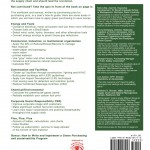Preview, Green Purchasing and Sustainability, Chapter 2
Editor’s note: this is the second of eight chapter previews of the new workbook and manual, Green Purchasing and Sustainability, that will be available to order in July 2011. To see all chapter previews, click here.
Ohm’s Law
The basis of electricity for engineers and physicists
We can’t see electricity so we don’t understand it, even though we use it constantly. It is easier to view electricity by comparing it to a more familiar and equivalent system, water.
Here are simplified basics that make electricity more user-friendly.
Ohm’s Law E = IR where
E is voltage, I is current, and R is resistance of a system
To compare an electrical system and a water system
- Voltage (Electromotive force) is equivalent to the pressure driving water and is measured by Volts
- Amperage (current or electron flow) is equivalent to the flow of the water and is measured by Amps or amperes
- Resistance Conductor size and material (copper, aluminum, etc) resist electron flow just as pipe size and material (concrete, plastic, etc) does in a water system. It is measured in Ohms.
An interesting development proceeds from Ohm’s Law that will help you understand the tangible relationship amongst voltage, amperage, and resistance. In a simplified system, power is equal to voltage multiplied by amperage. That is, E x I = Watts.
Applying Ohm’s law to a 120 W light bulb attached to a 120 volt (house) circuit shows amperage draw of 1 Amp.
- E x I = Watts
- Substituting , E @ 120 V and Watts @ 120 and solving for I
- I = 120/120 = 1 Amp
****************************************************************************************

